New L'Hydroptere test bed launched
Alain Thébault and his L’Hydroptère team yesterday launched their latest boat, L’Hydroptère.ch at the Decision SA shipyard in Ecublens. The proud father was accompanied by Jean-Mathieu Bourgeon, scientific manager of the project, the L’Hydroptère Design Team and their major partners, private banker Thierry Lombard, Managing Partner of Lombard Odier Darier Hentsch & Cie, Philippe Merk, CEO of the watchmaking manufacturer Audemars Piguet and of their official scientific advisor, the Swiss Federal Institute of Technology (EPFL) represented by Patrick Aebischer, its President.
L’Hydroptère.ch is a substantial departure from the original L’Hydroptère, the present world sailing speed record holder after she sailed an average speed of 51.36 knots on 4 November last year.
Firstly the new boat is one third scale test bed for their third boat - L’Hydroptère maxi. While L’Hydroptère captured the record over a 500m course, in L’Hydroptère maxi Thébault intends to capture the major offshore records, non-stop round the world, transatlantic, etc.
Whereas the first L’Hydroptère was a tri-foiler, the new boat, and the full sized version to be built in due course, are foil-born catamarans. L’Hydroptère.ch measures 10.85m LOA and with a beam of 10.40m, making her vaguely comparable to a D35.
The big difference with the two later boats is that they are designed to go offshore and this means that rather than being the ‘one trick pony’ the tri-foiler was, they must be able to sail fast on all points of sail and in all conditions, something the French neatly call ‘polyvalent’.
Thébault openly admits this: “With L’Hydroptere the boat is nice and it is very, very fast, but it is not an all-purpose boat, and the goal with L’Hydroptère.ch is to have the same performance like a D35 when the boat is floating and twice that speed when the boat is taking off.”
So from the outset the boat has been designed to have two modes – foiling and non-foiling (Archemedian, as Thébault calls it).
In foiling mode, the move to the catamaran platform has changed the concept a little. Firstly there is one more appendage in the water – with two T-foil rudders (instead of one) and similar principle lifting foils to the first boat. The main foils have a small hook at the end of them for end plate effect. There is also a lifting daggerboard in the flying centre hull.
Often foiler catamarans have been found not to be as fast as non-foilers, and this is attributed to the amount of drag induced by having four lifting surfaces in the water. So L’Hydroptère.ch has been designed so that her weather rudder will be lifted clear of the water when sailing. So once again L’Hydroptère.ch will foil on three lifting surfaces like the old boat.
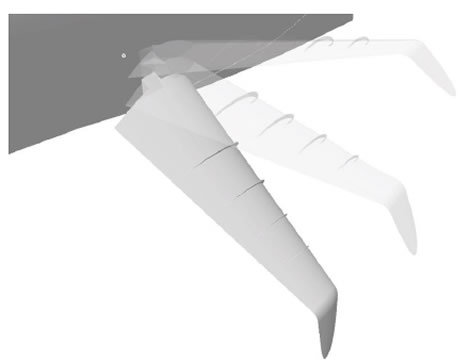
“With the main foil and the rudder in the same line when we have roll I think the control will be better on this design,” explains Thébault. “It was my feeling when I designed this boat and at the moment on the flight simimulator made by Airbus we saw a big difference of stability. Our first design was not good! I trust a lot in the new geometry with only one T foil in the line of the hull. If the stability will be better maybe we can push more!”
The rudders we suspect will also be a feat of engineering for not only will they turn like conventional rudders, but they will cant (like a Moth rudder) so that the fore and aft trim of the boat can be adjusted. And, as mentioned, they can be raised. According to Thébault they have modified the design of the rudder foils since the previous boat.
The clever bit is her non-foiling configuration. As was the case with the floats on the original boat, L’Hydroptère.ch has the same sea-plane style hulls that we first came across on Yves Parlier’s radical 60ft catamaran Mediatis Region Aquitaine, featuring a stepped hull. If you ponder this momentarily it makes perfect sense: the seaplane hull is designed to lift out and land on the water efficiently - just the same requirements as a foiler.
“I trust in this kind of design,” Thébault says. “With the classic Archimediean hull when you sail between 40-50 knots and suddenly touch the top of a wave you have a lot of drag, sometime you can capsize, but with the seaplane-type hull you have only lift, not drag when you touch. I trust in the combination of hydrofoil and this kind of hull and I like the combination of these two technologies.”
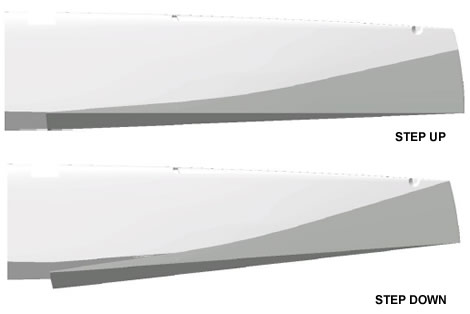
The problem with the stepped hull is that it is fine for seaplanes and powerboats but is extremely draggy at low speeds in light winds on sail boats. To solve this L’Hydroptère.ch has a step in her hull that is retractable – a panel is pushed down creating the step in the bottom of the hull with the help of a hydraulic ram and when retracted the plate returns flush with the hull. So the idea is that when the boat is foiling in waves or marginal conditions the step will be lowered.
The main lifting foils on L’Hydroptère.ch are the same design as the original boat, albeit scaled down. “We will start with the same design - we have reduced the scale, but we are happy because we know that this design is okay over 50 knots with a 1.5 tonne boat.”
However a significant difference will be that while the angle of immersion could be changed to a degree through hydraulics on the old boat, the lifting foils on the new boat can be lifted clear of the water to reduce drag in non-foiling mode.
Other features of the platform are the cross beams – which seem a little lo-tech because they appear to be box sections which must be draggy as they have no fairings. They also look extremely small in section… The aft beam is also further forward than you would find on a D35 or an Extreme 40. As with the D35s (and Alinghi 5) there is a flying centre hull to handle the fore and aft rig loads, with a bowsprit extending out of it. This centre hull is more bulky than on the D35s as it must also carry the box and associated structure of the central daggerboard and withstand the torsional loads induced by this.
Of course a potential problem with all this – the complex rudder and foil arrangements, raisable stepped hulls, an overall beam that is some 4m more than a D35 - is weight. However thanks to the team’s engineers, including the legendary Herve Devaux, Thébault says the weight of L’Hydroptère.ch is about the same as a D35 – just 1.4-1.5 tonnes.
While we haven’t seen photos of the rig yet, according to Thébault it will be a conventional multihull rig – they already have enough on their plates developing the platform. However Thébault says he might re-appraise this if his 500m record is broken. “Maybe we will use a wing to catch the record again, but for this kind of boat, under 50 knots there is no need. I would like to continue to have this record, so maybe I will need to come back in two years or in one year if a kitesurfer gets it. I think they will get it this autumn. The main difference is that we can sail around Europe with our boat and we can drink a Cup of tea at over 45 knots!”
The mast will be 20m tall with 155sqm of sail area upwind and 200 downwind.
The plan for L’Hydroptère.ch is to take the boat on its first sea trial on Lake Geneva in October while next year development work with the boat will continue outside of Switzerland where they can put the boat into an environment where there are waves. While his sponsors are pushing him to take the new boat to Hong Kong or New York, Thébault says he is looking to carry out some development elsewhere. “We need to sail in a swell to understand it because we have a very sophisticated measurement system and I would like to make some tests in waves and swell.”
He was very taken by Cowes on his visit this summer. “There are a lot of sailors in England. Humans are more important than carbon fibre to me.” (A fabulous sentence we now have stuck up on our wall as a reminder).
So a race with the new Mk2 Vestas SailRocket (due for launch this autumn) we put it to him? “Maybe I will be back if Paul [Larsen] or a kitesurfer beats this record. I think I will be back for 54! It is pleasure for me to have this record and I would like to continue to have it. I love Paul because he has a lot of passion. It was a pleasure to share [L’Hydroptere] with him and with Tim Daddo from Macquarie too. This spirit is to respect the other competitors for me is very very important. The spirit in Cowes is really good.”
However it should be remembered that L’Hydroptere.ch is a testbed for the future maxi and isn’t designed to be a rocket ship in its own right. “We will be afraid over 35 knots I think, but the potential is 45. I think the acceleration will be powerful on this one, more than on the first one. We need to take care,” warns Thébault.
Another program is also in development for the first L’Hydroptere, which they are considering taking out on a trans-Pacific record between Los Angeles and Honolulu next year.
A massive team has been involved with the development of the new boat. In addition to the design team, there are L’Hydroptère’s famous ‘Papés’, eight retired aerospace engineers who have been helping Thébault realise his dream for many years now. On the engineering side they have a partner with the Ecole Polytechnique Federale de Lausanne and work with HDS and MSE. While the appendages and other items were built by B&B in La Trinite-sur-Mer in France, the hulls and assembly have been at Alinghi’s builders, Decision SA in Switzerland.
“One thing is important for me today,” says Thébault. “I am proud of my boat, but first I am proud of my team - a lot of my team engineers are also sailors, a mix of cultures between sailors and engineers. I am very proud of my team, that is the most important thing for me. And my sponsors, because they trusted me before I got the world record.”

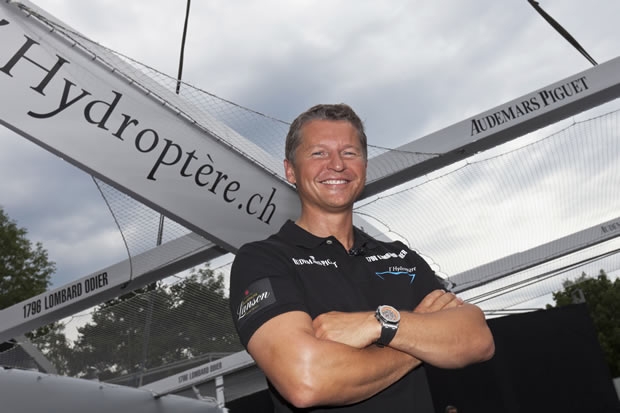
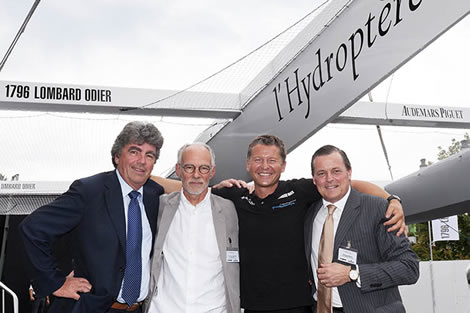
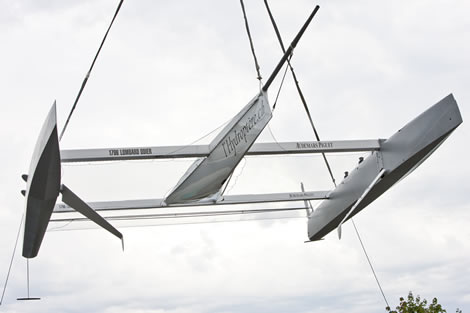
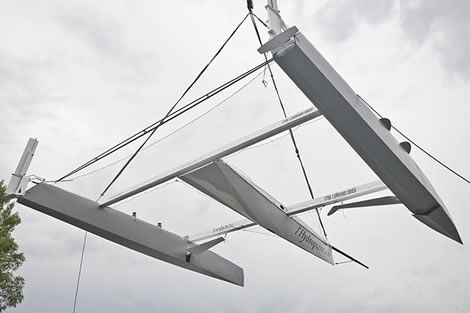
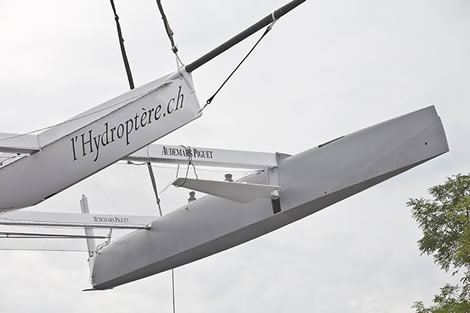
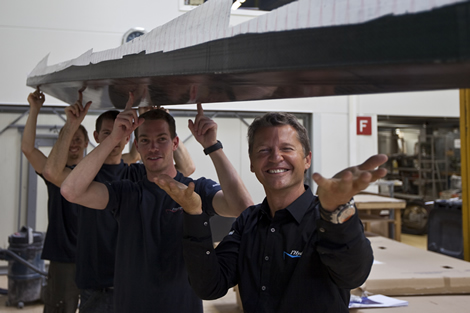
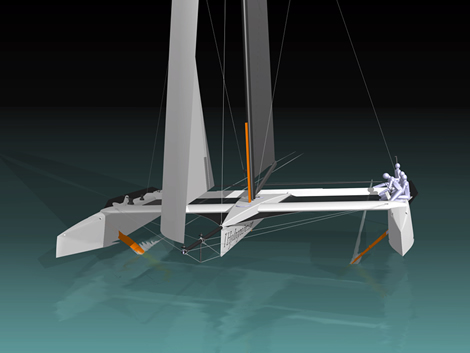







Latest Comments
Fraser 30/08/2010 - 19:26
Alain,great to have you in Cowes and to sail with you and the team. I look forward to your next adventure...381394 24/08/2010 - 17:54
What a lovely bloke - good luck to him and all the teamAdd a comment - Members log in